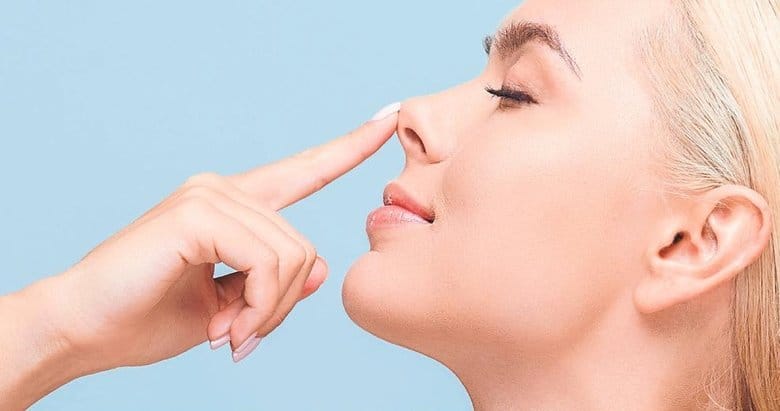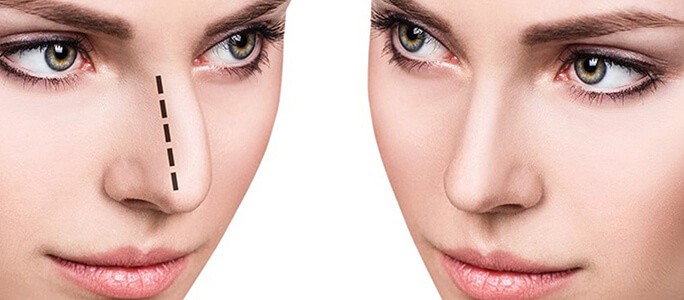Nose jobs, or rhinoplasty, are surgical procedures that alter the form of the nose for both cosmetic and practical purposes. It is just as common in Pakistan as it is anywhere else in the world. This comprehensive guide covers all aspects of rhinoplasty in Pakistan, including the method, its ins and outs, and what to expect before and after the treatment!
Table of Contents
What is Rhinoplasty & Understanding The Procedure
As the most prominent feature of the face, the nose has a major impact on the overall harmony and balance of the face. The general perception of a person’s face is frequently influenced by its prominence. If you’re unhappy with the proportions, symmetry, or overall look of your nose, rhinoplasty may be the way to go. The goal of this surgical operation is to create a more harmonious and attractive facial profile by shaping and refining the nose so that it blends in with the rest of the face.
When a person gets a rhinoplasty, their nose is reshaped to give them a more attractive and balanced appearance. This procedure has a multiplicative effect on their confidence and self-esteem. Rhinoplasty aims to address concerns like:
- Size: Reducing or augmenting the nose bridge or tip
- Shape: Correcting bumps, humps, or a hooked appearance
- Symmetry: Straightening a crooked nose
- Breathing problems: Improving airflow due to structural issues

What Are The Commom Types of Rhinoplasty in Pakistan
Open and closed rhinoplasty are the two most prevalent approaches to rhinoplasty in Pakistan, and each has its own set of benefits that surgeons take into account when planning a patient’s treatment.
- Open Rhinoplasty: When doing an open rhinoplasty, the surgeon uses a wider incision to have better access to and view of the nasal structures. A little cut is made at the base of the nose and continues upwards towards the columella, the narrow strip of tissue that divides the nostrils. Through this incision, the nasal skin can be lifted, enabling the surgeon to observe the bone and cartilage beneath. For more intricate procedures involving substantial framework reshaping or reconstruction, open rhinoplasty is the way to go. It enables fine-tuning, which in turn yields extensive cosmetic improvements.
- Closed Rhinoplasty: In contrast, a closed rhinoplasty leaves no visible scars or outside cuts; all incisions are made inside the nostrils. For subtle changes to the way the nose looks, this is usually the method of choice. Patients looking for mild modifications to their nasal profile can nevertheless achieve outstanding results with closed rhinoplasty, even though it gives less visibility compared to open rhinoplasty. There is less chance of scarring and a quicker healing period because no exterior incisions are made.
Considerations such as the patient’s goals for the treatment, the extent of the necessary correction, their nasal anatomy, and the surgeon’s level of experience determine whether an open or closed rhinoplasty is more appropriate. In order to accomplish the intended aesthetic goals while assuring excellent functional and cosmetic outcomes, the surgeon will examine these criteria during the initial consultation and prescribe the most suitable strategy.
To improve the aesthetics of the nose, patients in Pakistan can choose between open and closed rhinoplasty procedures, which meet their individual demands and preferences.
Who is a Candidate for Rhinoplasty in Pakistan?
To guarantee safe and effective results, there are a number of requirements that prospective rhinoplasty patients in Pakistan should fulfill. First and foremost, individuals need to be in excellent general health, free of any preexisting ailments that could compromise their safety during surgery or slow down their recovery. Candidates should also refrain from smoking, since this increases the risk of problems due to poor circulation and delayed recovery.
In addition, prospective patients should know exactly what they want out of the operation and have reasonable expectations. They need to be mentally and emotionally stable, ready to deal with the emotional and physical changes that come with cosmetic surgery, and aware of all the hazards that could be involved.
In order to determine candidacy and address personal concerns, it is vital to have a comprehensive consultation with a competent surgeon. If a candidate meets these requirements, they have the best chance of having a successful rhinoplasty in Pakistan with the fewest possible complications.
Consultation with a Rhinoplasty Surgeon in Pakistan
Choosing a qualified and experienced rhinoplasty surgeon is very important! Dr. Atta is a well-known plastic surgeon in Lahore, Pakistan, who specializes in rhinoplasty. Patients can expect a thorough and personalized visit with him. Dr. Atta starts by looking over the patient’s medical background, which includes any illnesses or medicines they are currently taking. After that, he does a full physical check, looking very carefully at the structure of the nose, the elasticity of the skin, and the proportions of the face.
Taking pictures is done so that they can be used as guides for planning the surgery. Patients are urged to be honest about their hopes and expectations for the procedure during the consultation, while Dr. Atta goes into great detail about the process, possible risks, and recovery time. In addition, patients may benefit from Dr. Atta’s use of computer imaging methods that let them see what might happen. Because he is skilled and dedicated, Dr. Atta makes sure that each patient gets the care they need and the results they want, making him the best rhinoplasty surgery in Lahore, Pakistan.
Understaning The Rhinoplasty Procedure in Pakistan
The specifics of a rhinoplasty procedure in Pakistan vary depending on the chosen technique and complexity. Here’s a general overview:
- Anesthesia: General anesthesia is typically used to ensure patient comfort.
- The procedure: Incisions are made based on the chosen technique (open or closed). The surgeon reshapes the underlying cartilage and bone to achieve the desired outcome. Sutures are used to close the incisions.
- Duration: The procedure can take anywhere from 1-4 hours, depending on the complexity.
How To Recovery after Rhinoplasty in Pakistan
In Pakistan, after rhinoplasty, you can expect some swelling, bruises, and pain, which usually gets worse in the first few days. A splint is often put on the nose to help it stay in place. In one to two weeks, the swelling and bruises will slowly go away, and the stitches will be taken out. Also, by 4 to 6 weeks, the swelling is less visible and breathing is better.
Over the next six months to a year, any remaining swelling will continue to go down, showing the nose’s final, more refined shape. Following your surgeon’s advice for after-surgery care and going to follow-up appointments will help you recover quickly and get the best results from your rhinoplasty.

Risks and Complications of Rhinoplasty in Pakistan
There are risks and possible problems with rhinoplasty in Pakistan, just like there are with any surgery. In general, the process is safe, but there is a chance of harm if it is not done as instructed. Some of these are infection, bleeding, trouble breathing, numbness, uneven results, and poor looks. To make an informed choice, you need to have a full conversation with your surgeon about these risks. If patients know about the possible problems that could happen, they can weigh the pros and cons and make sure they are ready for every part of the process. This makes rhinoplasty safer and more satisfying in Pakistan.
In Pakistan, societal beauty standards often favor a smaller, more defined nose. However, it’s crucial to prioritize natural-looking results that complement your facial features and ethnicity. Discuss your aesthetic goals openly with your surgeon to ensure alignment with realistic expectations.
Following your surgeon’s instructions for post-operative care is vital for optimal healing and minimizing risks. Here are some post-operative Care tips to avoid any risk!
- Applying ice packs to reduce swelling
- Maintaining proper head elevation while sleeping
- Avoiding strenuous activity
- Maintaining nasal hygiene with prescribed saline rinses
Rhinoplasty is a significant decision. Consider seeking emotional support from loved ones or a therapist throughout the process. Be prepared for the emotional adjustment as your appearance changes. If you’re considering traveling to Pakistan for rhinoplasty, factor in additional costs like travel, accommodation, and potential extended recovery time before returning home.
What Is The Cost of Rhinoplasty in Pakistan
The cost of rhinoplasty in Pakistan varies depending on factors like the surgeon’s experience, clinic location, and the complexity of the procedure. Generally, you can expect to pay between PKR 150,000 to PKR 500,000 or more. It’s important to prioritize choosing a qualified surgeon over cost alone.

Is There Any Alternatives to Rhinoplasty in Pakistan
Depending on your specific concerns, consider these alternatives to rhinoplasty in Pakistan:
- Non-surgical Rhinoplasty: As mentioned earlier, injectable fillers can address minor concerns.
- Septoplasty: This procedure focuses on correcting a deviated septum to improve breathing without altering the external appearance of the nose.
- Rhinoplasty Revision Surgery: If you’re unhappy with the outcome of a previous rhinoplasty, revision surgery can be performed by a qualified surgeon to address specific concerns. However, revision surgery is often more complex and expensive than the initial procedure.
In conclusion Rhinoplasty in Pakistan can be a transformative experience when approached thoughtfully. By educating yourself, choosing a qualified surgeon, and prioritizing your well-being, you can achieve a successful outcome and enhance your confidence. Remember, rhinoplasty is a personal decision. Take your time, weigh all factors, and choose what feels right for you.
FAQs
What is the typical cost of rhinoplasty in Pakistan?
The cost of rhinoplasty in Pakistan varies depending on factors such as the surgeon’s expertise, the complexity of the procedure, and the location of the clinic. On average, it ranges from PKR 100,000 to PKR 500,000.
How long does rhinoplasty surgery usually take in Pakistan?
The duration of rhinoplasty surgery in Pakistan can vary depending on the technique used and the extent of the correction needed. Generally, it takes between 1 to 4 hours to complete the procedure.
Is rhinoplasty in Pakistan covered by insurance?
In most cases, cosmetic rhinoplasty procedures are not covered by insurance as they are considered elective surgeries. However, if rhinoplasty is performed to correct breathing problems or functional issues, insurance coverage may apply. It’s best to consult with your insurance provider for specific details.
How soon can I return to work or daily activities after rhinoplasty in Pakistan?
Recovery times can vary from person to person, but most patients can expect to resume light activities and return to work within 1 to 2 weeks after rhinoplasty in Pakistan.
Will rhinoplasty surgery in Pakistan leave visible scars?
With closed rhinoplasty, all incisions are made inside the nostrils, resulting in no visible external scars. However, with open rhinoplasty, a small incision is made at the base of the nose, which may leave a faint scar that typically fades over time and is well concealed.
What are the main differences between open and closed rhinoplasty?
Open rhinoplasty provides better visibility and access to nasal structures, making it suitable for more complex procedures. Closed rhinoplasty, on the other hand, involves incisions made entirely inside the nostrils, resulting in no external scarring and a quicker recovery time.
Are the results of rhinoplasty permanent?
While rhinoplasty can produce long-lasting results, the final outcome may continue to evolve over time as residual swelling resolves and tissues settle. Most patients can expect to enjoy the results of their rhinoplasty for many years, although natural aging processes may affect the appearance of the nose in the future.

